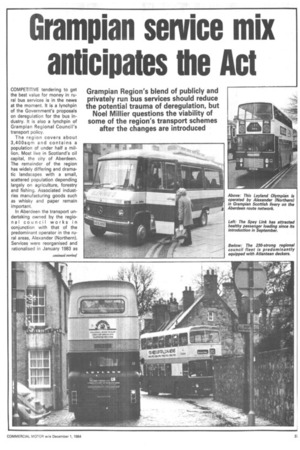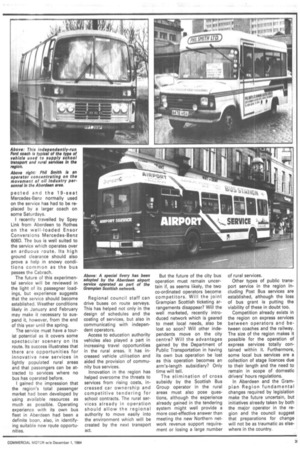Grampian service mix anticipates the Act
Page 39

Page 40

Page 41

If you've noticed an error in this article please click here to report it so we can fix it.
COMPETITIVE tendering to get the best value for money in rural bus services is in the news at the moment. It is a lynchpin of the Government's proposals on deregulation for the bus industry. It is also a lynchpin of Grampian Regional Council's transport policy.
The region covers about 3,40 Osqm and contains a population of under half a million. Most live in Scotland's oil capital, the city of Aberdeen. The remainder of the region has widely differing and dramatic landscapes with a small, scattered population depending largely on agriculture, forestry and fishing. Associated industries manufacturing goods such as whisky and paper remain important.
In Aberdeen the transport undertaking owned by the regional council works in conjunction with that of the predominant operator in the rural areas, Alexander (Northern). Services were reorganised and rationalised in January 1983 as
a result of the Scottish Bus Group SCOTMAP market survey. Old protectionist restrictions were swept away and a jointly operated and integrated Grampian Scottish route network is now run with about 80 per cent of the mileage covered by the municipal undertaking and the remainder by the nationalised operator.
All buses, irrespective of ownership operate in the same livery under the same brand name.
A range of prepaid tickets is available and their use is increasing by around 45 per cent a year. It now accounts for around five and a half per cent of all ticket sales.
The regional council markets the city network and produces a route map and timetables. Plans exist for centralised and rationalised engineering facilities for both bus fleets in Aberdeen, but discussions on this are overshadowed by the prospect of the two operators becoming direct competitors in the future. An autonomous commercial joint engineering facility could be a possible solution.
Both the regional council and the Scottish Bus Group operator are efficient operators and both are involved in private hire and school contract transport as well as stage carriage operations.
In the rural areas Alexander (Northern) remains the predominant operator with a network receiving over half a million pounds revenue support annually from the region. The company has already told the
Above: Glennie's of Newmill near Keith, Banffshire, operates the Spey Link which passes through some of the remotest countryside in Britain.
regional council that it plans to eliminate cross subsidy from this network as part of its response to the emerging operating environment. As a result its revenue support requirement for the existing network will rise significantly.
In areas where the traditional Alexander (Northern) services do not operate or have ceased to be viable the regional council makes full use of available transport. Rural bus services are provided by a number of independent operators and some are already operated on a competitive tender basis on behalf of the council. As the regional council is a transport operator in its own right with its Aberdeen fleet and its own education authority minibus fleet it is able to apply for and hold road service licences for rural services.
These services are advertised and organised by the planning department of the region and operated by the most costeffective means available. In many cases this means a private operator under contract although in some cases education authority minibuses are run by volunteers under a community bus permit. In one case local taxi firms provide a driver for specific bus services as a reult of a competitive tender.
A comprehensive travel guide detailing all the public transport in the region is produced by the council. Presented in looseleaf form it has separate sections on the Grampian Scottish services in the city, the Northern Scottish service network, British Rail, other operators and express coaches. The guide aims to include all express coach operations including those run by independent and Scottish Bus Group operators.
At present 26 bus routes operate in the region as a result of competitive tendering. Of these six are experimental and three are temporary. Around 14 operate under road service licences held by the regional council. The lengths of the contracts and the terms under which they operate vary to suit the needs of each route.
One recently introduced link that has provided a number of new travel opportunities for some rural communities is the Spey Link service which commenced operation on September 25. This service is operated on behalf of the council by Eric Glennie of Newmill. The service operates on Tuesdays and Saturdays for shopping in Aberdeen. Its passenger loadings have been greater than ex pected and the 1 9-seat Mercedes-Benz normally used on the service has had to be replaced by a larger coach on some Saturdays.
I recently travelled by Spey Link from Aberdeen to Rothes on the well-loaded Ensor Conversions Mercedes-Benz 6080. The bus is well suited to the service which operates over an arduous route. Its high ground clearance should also prove a help in snowy conditions common as the bus passes the Cabrach.
The future of this experimental service will be reviewed in the light of its passegner loadings, but experience suggests that the service should become established. Weather conditions likely in January and February may make it necessary to suspend it, however, from the end of this year until the spring.
The service must have a tourist potential as it covers some spectacular scenery on its route. Its success illustrates that there are opportunities for innovative new services in lightly populated rural areas and that passengers can be attracted to services where no bus has operated before.
I gained the impression that the region's total passenger market had been developed by using available resources as much as possible. Operating experience with its own bus fleet in Aberdeen had been a definite boon, also, in identify ing suitable new route opportunities. Regional council staff can drive buses on route serveys. This has helped not only in the design of schedules and the costing of services, but also in communicating with independent operators.
Access to education authority vehicles also played a part in increasing travel opportunities in the rural areas. It has increased vehicle utilisation and aided the provision of community bus services.
Innovation in the region has helped overcome the threats to services from rising costs, increased car ownership and competitive tendering for school contracts. The rural services already in operation should allow the regional authority to move easily into the environment which will be created by the next transport act. But the future of the city bus operation must remain uncertain if, as seems likely, the two co-ordinated operators become competitors. Will the joint Grampian Scottish ticketing arrangements disappear? Will the well marketed, recently introduced network which is geared to meet local needs, also be lost so soon? Will other independents move on the city centre? Will the advantages gained by the Department of Public Transportation in having its own bus operation be lost as this operation becomes an arm's-length subsidiary? Only time will tell.
The elimination of cross subsidy by the Scottish Bus Group operator in the rural areas must also pose questions, although the experience already gained in the tendering system might well provide a more cost-effective answer than meeting the new Northern network revenue support requirement or losing a large number of rural services.
Other types of public transport service in the region including Post Bus services are established, although the loss of bus grant is putting the viability of these in doubt too.
Competition already exists in the region on express services between operators and between coaches and the railway. The size of the region makes it possible for the operation of express services totally contained within it. Furthermore, some local bus services are a collection of stage licences due to their length and the need to remain in scope of domestic drivers' hours regulations.
In Aberdeen and the Grampian Region fundamental changes required by legislation make the future uncertain, but initiatives already taken by both the major operator in the region and the council suggest that preparations for change will not be as traumatic as elsewhere in the country.




























































































